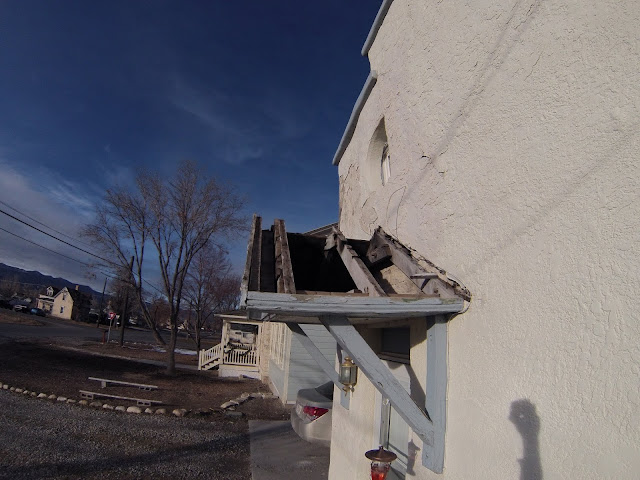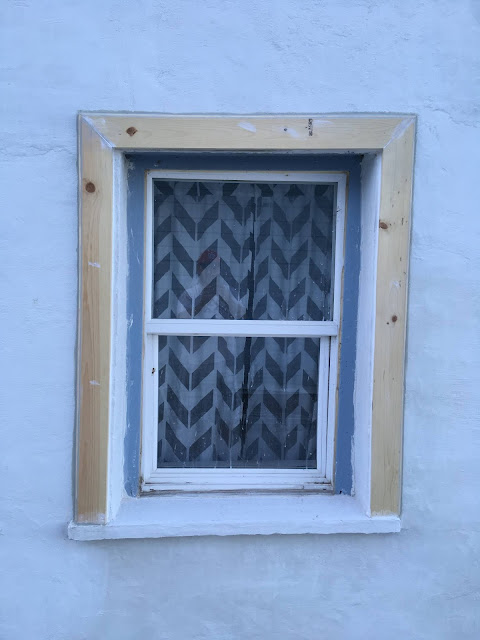Emma Sophia Pedersen (aka Peterson or Petersen) was born in
Copenhagen Denmark on July 27, 1850 to Peder and Sophie Pedersen. Her father died when she was just three years
old, leaving her mother a young window with 6 small children. Sophie was baptized
after experiencing a vision of Mormon missionaries coming to visit her. Sophie and her children joined the Willie Company
and traveled from Liverpool to Iowa, then the 1300 miles on foot to Salt Lake City via handcart. Emma and F.Walter Cox married October 11, 1869 in
the Endowment House (SLC) when she was 19 years old. In around 1870, Walter built the small stone house, which was
later stuccoed, next door to the “big house” where she resided with her
children. This unique house is a rare remaining example of the Nauvoo-type stepped gable. The untimely death of F.W.C on June 4, 1979 left Emma with 4 young children,
all under the age of 6. Emma ultimately
married twice more and had three children with each husband. She died at the age of 50 on November 22,
1900 leaving a number of young children and is buried in Manti.
A more detailed biography, compiled by Virginia Grundvig, can be found here: https://www.familysearch.org/photos/artifacts/2237664?cid=mem_email
A couple of years ago, Barbara Sue Barton and her son Kent, came over to our house to share some of their historical notes on their grandmother Emma which was a real treat as we couldn't find much information about FWC's youngest wife. My family descends through Emeline, FWC's first wife, and through her first son, Fred jr. which makes me the great X4 grandson of FWC. The generational gap for Barbara is much shorter with FWC being her great grandfather. In fact, her grandmother Lucinda Bell Cox spent her childhood in this little bungalow next to the FWC big house. Having purchased the Cox rock house in 2015, it was always our hope and dream to include this historic house into our Cox homestead.
On January 16, 2018 the stars aligned and we were able to acquire the Emma Pedersen Cox bungalow. The house was in pretty rough shape but we saw a lot of potential and hope to give this historic home a new life.
My dad and I standing in front of both FWC homes, the "big house" pictured left and the small bungalow to the right.
The bungalow was in serious need of rescuing. Pictured here are the local firemen who extinguished a fire started by a stray chimney spark that caught the front door overhang on fire. The fire was actually discovered by fellow Cox descendants Andy and Alex Cox shortly after church, March 5, 2017.
The overhang remained in this condition until we were able to purchase the house and begin repairs.
The first project was to upgrade the electrical by burying the primary power supply which historically has hung inches from the house, out to the street and then back again to the breaker box.
Manti City is working with us to remove an electrical line in the cluster that powers a street light down past the intersection.
In addition to burying the power lines, our next project was to remove the swamp cooler (that has caused moisture problems) and add a modern AC system.
Another angle of the power lines and swamp cooler.
Hill Heating and Air installing the AC condenser.
We took advantage of the hole and added a small window!
Next was to repair the dilapidated exterior stucco. We purchased a masonry grinder wheel to gnaw off the high points and roughen up the existing surface. We then applied concrete adhesive and attached the fiberglass reinforced concrete spread.
Gilberto, our masonry expert, shows us out it's done.
We broke out our scaffolding, that we used to re-point our entire stone house, to reach the elevated walls. That scaffolding has seen a lot of use!
Gilberto added quite a bit of wood trim to fill cracks and uneven parts of the wall surface.
We loved how Gilberto framed the window with wood trim.
The back wall of the wood/stucco addition was in horrible shape.
We trimmed around the fascia and soffit where is was rough rafters before.
We removed the stucco on the gable face so we can install cedar shakes.
The results after my dad removed the stucco from both the gable face and ceiling.
We found an old picture of the bungalow (see below) that shows what was probably the original front porch. Although we considered replicating was was there, we opted to keep the current door cover as it is also very old, probably 100+ years and is in good structural condition. Today, there is also a culinary water faucet located front and center of the western elevation.
Above is the oldest picture currently found of the Emma Peterson Cox bungalow. Note the full width front porch and beautiful 4-panel front door with possible transom above. The address also appears to be "56", now 76. Even way back when the picture was taken, probably around the turn of the century, it was stuccoed. Also, note the trees between this house and the FWC "Big House" to the north/left.
As the only known surviving example of a Nauvoo-style gable house in Sanpete (in Utah?), many descendants and onlookers have wondered why Emma and Walter Cox would construct such a building. Perhaps this decision was influenced by the Cox family's time spent living in and around Nauvoo during the 1840s (reference above excellent example). Perhaps this decision was influenced by stepped gables being a popular architectural style for churches in Denmark at the time. I like to think that Walter wanted to build something unique for Emma and that they decided on a style that linked their two worlds together.
Popular Danish churches that might have inspired the Emma Petersen Cox house.
This is a copy of a picture from the county records, most likely taken in the late 1970s. Note the large trees in-between both the F. Walter Cox and Orville Sutherland Cox houses. The newer door awning clearly visible.
This is a from a series of pictures from a early 1980s architecture report from a school assignment I believe. Aside from the radical color change, there is a chimney on the east gable that isn't there today. The windows on the addition are also different (smaller) in this picture.
This is how the bungalow looked when we first tried to buy it back in 2014. The white picket fence was dilapidated by this point and was removed the falling spring by me and Don White, owner of the OSC to the south with the permission of the new owner. Note the carport and large shed.
Okay, back to our remodel... Gilberto started sanding down the ol' Nauvoo Step Gable and made a startling discovery...
Underneath all the layers of stucco is beautiful oolite limestone! We had read that this was a stone house but an exposed internal wall indicated that the stone was of poor quality with mud composing most of the wall structure. Our original plan was to simply re-stucco the house but now doing so seems criminal. Since it's too late in the season to point the stone, we have some time to figure out next steps. We are leaning on peeling off the stucco on this west/street facing wall and leaving the stucco everywhere else.
Shown here is busting out the loose concrete base trim and attaching anchor nails for the new concrete trim.
Note the nails every 10" or so.
Forms holding in new concrete baseboard.
We encased the outlet midway down the new trim.
Forms holding in new concrete baseboard.
We encased the outlet midway down the new trim.
Dad and Gilberto working on the south wall.
Tyler and Bill from House of Glass installing a new door light (window) for the side/kitchen door. We ordered a historic-looking 2-glass panel front door which had to be custom ordered of course given the small door opening of 30".
Like F. Walter Cox, we are big fans of windows and natural light, so we've trying to incorporate windows as much as possible into our house projects. With the doors, we are adding three new window areas to the bungalow... each door and then a small window where the swamp cooler was previously mounted.






















































